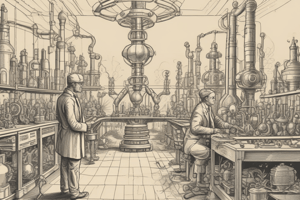Podcast
Questions and Answers
In an E1 reaction, what is the fate of the stereochemistry of the starting material?
In an E1 reaction, what is the fate of the stereochemistry of the starting material?
- It is racemized
- It is inverted
- It is lost
- It is retained (correct)
What is a characteristic of a good leaving group in an E1 reaction?
What is a characteristic of a good leaving group in an E1 reaction?
- It is a weak acid
- It can stabilize a negative charge (correct)
- It is a strong base
- It is a strong nucleophile
What is the effect of alkyl substituents on the carbocation intermediate in an E1 reaction?
What is the effect of alkyl substituents on the carbocation intermediate in an E1 reaction?
- They stabilize the carbocation by donating electron density (correct)
- They increase the steric hindrance
- They have no effect on the carbocation
- They destabilize the carbocation
What is the rate-determining step in an E1 reaction?
What is the rate-determining step in an E1 reaction?
How do polar solvents affect the rate of an E1 reaction?
How do polar solvents affect the rate of an E1 reaction?
What is the relative stability of primary, secondary, and tertiary carbocations in an E1 reaction?
What is the relative stability of primary, secondary, and tertiary carbocations in an E1 reaction?
Flashcards are hidden until you start studying
Study Notes
E1 Reaction
Stereochemistry
- E1 reaction is a stereospecific reaction, meaning the stereochemistry of the starting material is retained in the product
- The reaction proceeds through a planar carbocation intermediate, which can adopt a configuration that minimizes steric hindrance
- The leaving group departs, and the nucleophile attacks from the opposite side, resulting in retention of stereochemistry
Leaving Groups
- E1 reaction requires a good leaving group, such as a halogen (Cl, Br, I) or a tosylate (-OTs)
- The leaving group should be able to stabilize a negative charge, allowing it to depart readily
- Weak bases, such as Cl- or Br-, are not suitable leaving groups for E1 reactions
Carbocation Stability
- Carbocation stability is crucial in E1 reactions, as it affects the rate of the reaction
- The more stable the carbocation, the faster the reaction
- Alkyl substituents, such as methyl or ethyl groups, stabilize the carbocation by donating electron density
- Tertiary carbocations are more stable than secondary, which are more stable than primary
Rate-determining Step
- The rate-determining step in an E1 reaction is the formation of the carbocation intermediate
- This step is slow because it requires the formation of a high-energy intermediate
- The rate of the reaction is influenced by the stability of the carbocation and the ability of the leaving group to depart
Solvent Effects
- Solvent effects play a significant role in E1 reactions, as the solvent can influence the stability of the carbocation intermediate
- Polar solvents, such as water or alcohols, can stabilize the carbocation by solvating it, thereby increasing the reaction rate
- Non-polar solvents, such as hexane or toluene, do not stabilize the carbocation, leading to a slower reaction rate
Studying That Suits You
Use AI to generate personalized quizzes and flashcards to suit your learning preferences.




